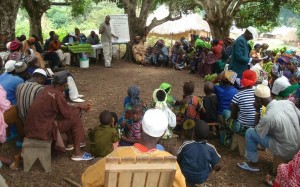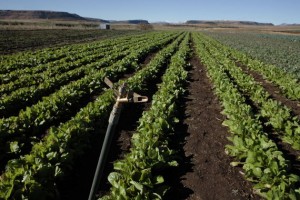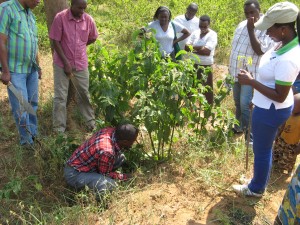 A review of World Vision’s Farmer Managed Natural Regeneration (FMNR) project in East Rwanda has revealed an increase in the rates of adoption from 7,500 to 13,400 smallholder farmers. The success attributed to extension agents who by word of mouth spread the word on the land generation technique has also translated to an increase in areas managed with FMNR practices and transformed livelihoods through the sale of grafted seedlings.
A review of World Vision’s Farmer Managed Natural Regeneration (FMNR) project in East Rwanda has revealed an increase in the rates of adoption from 7,500 to 13,400 smallholder farmers. The success attributed to extension agents who by word of mouth spread the word on the land generation technique has also translated to an increase in areas managed with FMNR practices and transformed livelihoods through the sale of grafted seedlings.
Category Archives: News
The Sustainable Development Solutions Network (SDSN) has established 12 Thematic Groups comprising leading scientists, engineers, academics and practitioners from business and civil society to promote solutions to key challenges of sustainable development. The Thematic Groups are solution oriented rather than research oriented and aim to identify practical solutions to the challenges of sustainable development.
Dr. Keith Shepherd has been invited as a member of the new Thematic Network on Data for Sustainable Development. This thematic group will serve as an information and education hub on data collection, processing, and dissemination for sustainable development. It seeks to identify solution-orientated approaches to measuring progress on the Sustainable Development Goals (SDGs), to strengthen the cross-sectoral and multi-scalar analysis of data for SDG monitoring, and encourage greater frequency and quality of data production and monitoring.
A regional consultation on agro forestry on Thursday underscored the need for enabling policies to ensure that farmers get technology and financial incentives to integrate trees and shrubs on farmland for developing resilience to climate change.
“India has the most progressive agro forestry policy in the world,’’ Director-General of Kenya-headquartered ICRAF (World Agro forestry Centre) Tony Simons told The Hindu on the sidelines of the conference here. “This needs to be followed up with investments and better coordination between States.’’
“There is a lot of degraded land and farm land without trees in India. The key is to add trees to the landscape,’’ he said. Agro forestry is defined as a land use system which integrates trees and shrubs on farmlands and rural landscapes to enhance productivity, profitability, diversity and ecosystem sustainability. It is practised in both irrigated and rain-fed conditions and is an important component for bringing about resilience in agriculture to face up to climatic changes.
Mr. Simons does not believe Indian farmers need to earn carbon credits especially the ones with small holdings so long as the country moves in the direction of increasing its green cover. “The important thing is to align the needs of small farmers with that of the village, the State, the country and the world,’’ he said. And for this, he feels, small private sector entrepreneurs as well as big multi- national companies will have to be incorporated in public-private partnership mode.
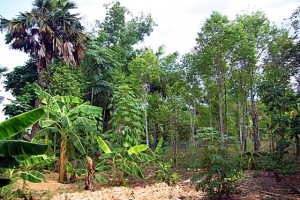 In Ho Ho sub-watershed in north-central Viet Nam, farmers do not deploy systems that mix trees and annual crops, except in their home gardens. In the eyes of the farmers, it is not possible to cultivate different plants together outside of a home garden. Certainly, they say, trees cannot be planted between annual crops.
In Ho Ho sub-watershed in north-central Viet Nam, farmers do not deploy systems that mix trees and annual crops, except in their home gardens. In the eyes of the farmers, it is not possible to cultivate different plants together outside of a home garden. Certainly, they say, trees cannot be planted between annual crops.
These were the initial findings by researchers from the World Agroforestry Centre who interviewed groups of farmers and other people in the district as part of the Climate-Smart, Tree-Based, Co-Investment in Adaptation and Mitigation in Asia (Smart Tree-Invest) project, which is co-funded by the International Fund for Agriculture Development and the CGIAR Research Program on Forests, Trees and Agroforestry.
During the discussions, farmers cited a number of barriers to agroforestry systems that grow trees and annual crops together: land size, flooding, lack of knowledge, scarcity of seedlings and a dearth of markets for tree products. These obstacles were then further discussed with other key people, such as commune and village leaders and officers of the Department of Agriculture and Rural Development, to explore potential solutions. The researchers, together with the farmers and others, developed options for overcoming the obstacles. Trees have been proven to increase farm resilience to climate extremes while also improving livelihoods and enhancing environmental services.
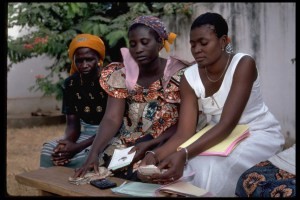 With just over two months left till a new international climate change agreement is being finalised in Paris, the Montpellier Panel is launching a new report today, “The Farms of Change: African Smallholders Responding to an Uncertain Climate Future”, which addresses some of the key challenges to climate-proof Africa’s smallholder farmers.
With just over two months left till a new international climate change agreement is being finalised in Paris, the Montpellier Panel is launching a new report today, “The Farms of Change: African Smallholders Responding to an Uncertain Climate Future”, which addresses some of the key challenges to climate-proof Africa’s smallholder farmers.
As we all know, two of the greatest challenges of the 21st century are the increasing demands for food, water and energy from a growing population and – climate change. Agriculture and smallholders are central to both, perhaps nowhere more so than in Africa. Africa is already battling against the impacts of climate change and smallholder farmers are amongst the most vulnerable with the least capacity to adapt. Rising temperatures signal more extreme weather events that will put lives and livelihoods at greater risk, increasing smallholders’ vulnerability to drought, famine and disease. And whilst progress has been made during the last two decades to reduce hunger and to improve farmers’ livelihoods, climate change jeopardises these gains.
High levels of poverty and underdevelopment combined with insufficient infrastructure exacerbate the already severe impacts of global warming on resources, development and human security. In order to adapt to and mitigate the effects of climate change, international organisations and governments must help smallholders to reduce and off-set greenhouse gas (GHG) emissions.
Climate change remains one of the biggest threats to transforming Africa from a continent of poverty to prosperity. Africa’s attractiveness for investors has been on the rise, second only to Asia. Ethiopia, Kenya, Tanzania, Mozambique, Zambia and Cote d’Ivoire are among 22 economies in sub-Saharan Africa that are expected to grow by more than five percent this year. According to Ernst & Young, these trends are driven partly by recent economic growth and gradual diversification out of the oil and gas sectors into consumer-facing industries such as real estate, hospitality and construction. Yet the investment to ensure that all this growth is not undone as climate change tightens its grip on the continent is simply not there.
Temperature rises in Africa are predicted to rise faster and get warmer than any other continent. As mean temperatures exceed 2˚C, losses in the agricultural sector could amount to up to 7 per cent of GDP by 2100. As agriculture still employs 65 per cent of Africa’s labor force and accounts for 32 per cent of gross domestic product, climate change will undeniably limit growth and may jeopardize progress to date.
The current investment climate
Between 2010 and 2050, the annual estimated cost of adaptation to climate change in sub-Saharan Africa is as much as $50 billion for the entire continent. Despite there being around US$25 billion pledged to over 50 climate funds, this is but a drop in the ocean of the amount of resources that are needed. Furthermore, Africa still only receives a small proportion of this financing: between 2003 and 2010, it has received just US$2.3 billion. Nigeria and South Africa are the only African countries that have received support for solar and wind power through the Clean Technology Fund. Just 3 per cent of the funds in the Clean Development Mechanism, that allows countries to invest in emission-reducing projects in other countries instead of making costlier adjustments in their own countries, are going to Africa.


